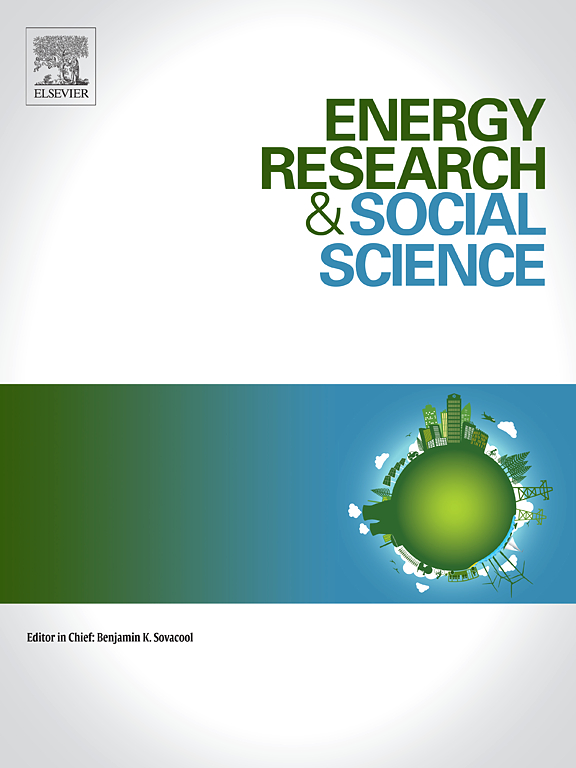Imagining a hydrogen economy: From grand technological utopia to enabler of the energy transition in three waves since the 1970s
IF 6.9
2区 经济学
Q1 ENVIRONMENTAL STUDIES
引用次数: 0
Abstract
Conceptions of a future hydrogen economy have undergone a significant evolution over the past 50+ years. This study identifies three distinct ‘Waves’, or periods of high expectations for a hydrogen economy. The First and Second Waves were followed by declining optimism; the Third Wave is ongoing today. The three Waves are analyzed through a multi-method literature review, and we specifically analyze the First Wave through key historical sources and contextual analysis. We argue that the hydrogen economy emerged in the 1970s as a techno-utopian narrative within the scientific community, where hydrogen was envisioned as the ultimate energy carrier, driven by nuclear energy. Characteristics of the techno-utopian narrative include utopian terminology, dystopian future images, and neglect of negative side effects. During this period, the hydrogen economy did not develop beyond the conceptual phase. The Second Wave, starting in the mid-1990s, witnessed a resurgence of interest in hydrogen, particularly in the mobility sector. Governmental support and media portrayal fueled public enthusiasm, but practical challenges and misleading information resulted in disillusionment with the hydrogen economy ideal by the late 2000s. Today, in the Third Wave, hydrogen is repositioned as an energy vector for a more sustainable future, primarily as a carrier of (variable) renewable energy sources. Lessons from earlier Waves emphasize the importance of affordable renewable energy for hydrogen production, realistic objectives, a developed hydrogen infrastructure, and cross-sector collaboration. By addressing these elements, the Third Wave can avoid past pitfalls and advance hydrogen’s role in a sustainable energy future.
想象氢经济:从宏大的技术乌托邦到20世纪70年代以来三波能源转型的推动者
在过去的50多年里,未来氢经济的概念经历了重大演变。这项研究确定了三个不同的“浪潮”,即对氢经济的高期望时期。在第一和第二波浪潮之后,乐观情绪下降;第三次浪潮今天仍在继续。通过多种方法的文献回顾来分析这三波浪潮,我们通过关键的历史资料和语境分析来具体分析第一波浪潮。我们认为,氢经济出现于20世纪70年代,是科学界的一种技术乌托邦式的叙述,氢被设想为最终的能源载体,由核能驱动。技术乌托邦叙事的特点包括乌托邦式的术语、反乌托邦式的未来图景以及对负面影响的忽视。在此期间,氢经济并没有超越概念阶段。从20世纪90年代中期开始的第二次浪潮见证了对氢的兴趣的复苏,特别是在移动领域。政府的支持和媒体的描述激发了公众的热情,但实际的挑战和误导性的信息导致了2000年代末对氢经济理想的幻灭。今天,在第三次浪潮中,氢被重新定位为更可持续未来的能源载体,主要是作为(可变的)可再生能源的载体。前几次浪潮的经验教训强调了可负担的可再生能源对制氢、现实目标、发达的氢基础设施和跨部门合作的重要性。通过解决这些因素,第三次浪潮可以避免过去的陷阱,并推进氢在可持续能源未来中的作用。
本文章由计算机程序翻译,如有差异,请以英文原文为准。
求助全文
约1分钟内获得全文
求助全文
来源期刊

Energy Research & Social Science
ENVIRONMENTAL STUDIES-
CiteScore
14.00
自引率
16.40%
发文量
441
审稿时长
55 days
期刊介绍:
Energy Research & Social Science (ERSS) is a peer-reviewed international journal that publishes original research and review articles examining the relationship between energy systems and society. ERSS covers a range of topics revolving around the intersection of energy technologies, fuels, and resources on one side and social processes and influences - including communities of energy users, people affected by energy production, social institutions, customs, traditions, behaviors, and policies - on the other. Put another way, ERSS investigates the social system surrounding energy technology and hardware. ERSS is relevant for energy practitioners, researchers interested in the social aspects of energy production or use, and policymakers.
Energy Research & Social Science (ERSS) provides an interdisciplinary forum to discuss how social and technical issues related to energy production and consumption interact. Energy production, distribution, and consumption all have both technical and human components, and the latter involves the human causes and consequences of energy-related activities and processes as well as social structures that shape how people interact with energy systems. Energy analysis, therefore, needs to look beyond the dimensions of technology and economics to include these social and human elements.
 求助内容:
求助内容: 应助结果提醒方式:
应助结果提醒方式:


